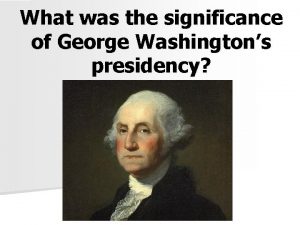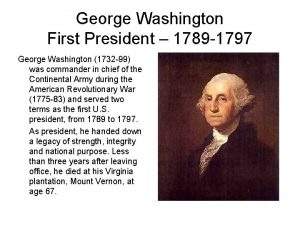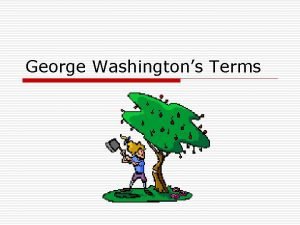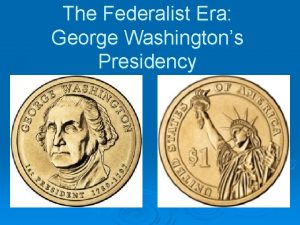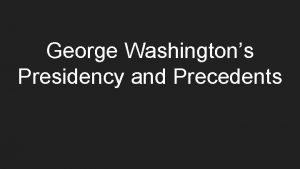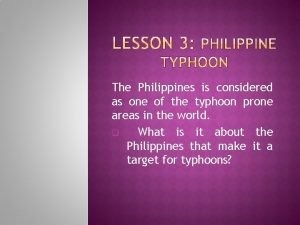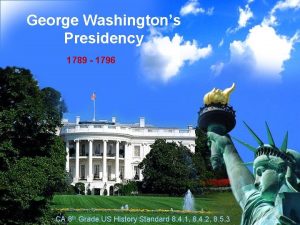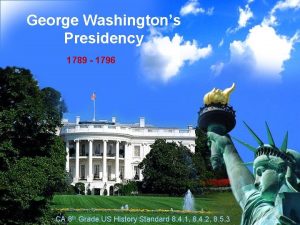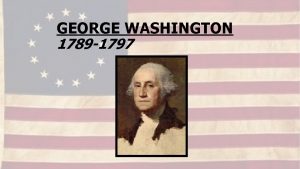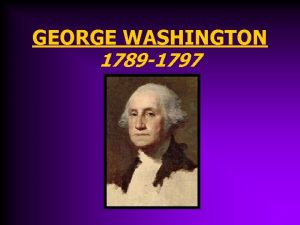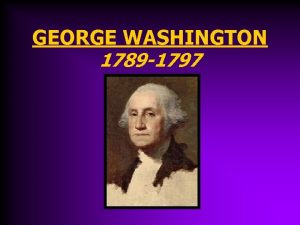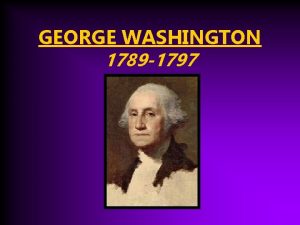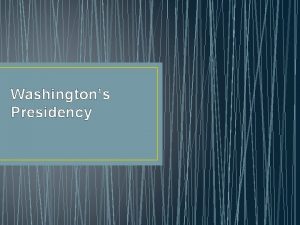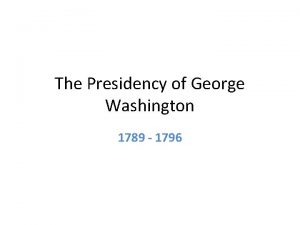George Washingtons Presidency 1789 1796 CA 8 th









- Slides: 9

George Washington’s Presidency 1789 - 1796 CA 8 th Grade US History Standard 8. 4. 1, 8. 4. 2, 8. 5. 3

George Washington was sworn in as the first President on April 30, 1789 Washington created the job of President since the Constitution did not state his daily duties. Everything he did set a precedent (or example) for future Presidents to follow. First precedent - Create a cabinet of advisers State Department – Thomas Jefferson Treasury Department – Alexander Hamilton War Department – Henry Knox Attorney General – Edmund Randolph Postmaster General – Samuel Osgood Every President since Washington has had a cabinet of advisers

The First Congress Several problems faced the first Congress. 1. Create a Bill of Rights. The Bill of Rights was promised in exchange for the ratification of the Constitution. The Bill of Rights was written by James Madison using ideas from the English Bill of Rights, John Locke, and the Virginia Declaration of Rights. 2. Create the court system. Congress passed the Judiciary Act of 1789 giving detailed information on how our courts would be organized. The Judiciary Act also set up the Supreme Court with one Chief Justice and 5 Associate Justices. John Jay was selected as the first Chief Justice of the Supreme Court.

Hamilton and our Debt As Secretary of the Treasury it fell to Alexander Hamilton to find a way to pay America’s war debts. To help fund the war America had sold war (treasury) bonds and they were now coming due. Hamilton’s Plan 1. Buy up the old federal bonds then sell new bonds 2. Buy up the old state bonds then sell new bonds. Part 2 of Hamilton’s plan was opposed by the Southern states, James Madison and many others that didn’t want to pay other states debts. Hamilton also asked congress to impose a tariff (tax) on imported goods. The tariff was great for the North. Their factories were making a great profit. The tariff was bad for the South. They were agricultural and imported most of their goods which just became more expensive.

The Whiskey Rebellion More money was needed to pay off debts and build a new capitol. In 1794 Congress passed a tax on liquor. Many farmers grew grains and corn and used some to make Whiskey. They refused to pay the tax saying it was too much like taxes passed by England. Mobs of people, throughout the states, rebelled against the tax. Some tax collectors were attacked. Some rebels decided to march on Pittsburg, PA. Washington called up 13, 000 militia to put down the rebellion. Most rebels gave up upon hearing about the militia but some were taken prisoner. Washington later pardoned them. The successful conclusion to the Whiskey Rebellion proved that the United States now had a strong government under the Constitution.

Washington’s Foreign Policies During the revolution after the Battle of Saratoga, America signed a treaty giving France permission to use our ports to supply their ships in their battle against England. This was in exchange for their help during the revolution. The Problem: Washington did not think honoring that treaty was wise for such a new, young country Washington’s Solution: In April 1793, he issued the Neutrality Proclamation stating that: 1. The U. S. would not take sides in the French revolution 2. No American would take warlike action against the British or French. The Results: Both France and England started attacking our ships to stop America from trading with the other country. The British had attacked and captured so many American vessels in the West Indies as we tried to trade with France that Washington finally sent John Jay over to negotiate with the British.

Jay’s Treaty In January 1794 Jay negotiated a treaty with Britain that stated: 1. The British agreed to pay for the damage to our ships but, they didn’t agree they wouldn’t attack again. 2. The British agreed to leave their forts in the Ohio Valley. 3. The Americans agreed to pay their revolutionary war debts. Many in Congress thought the treaty was too easy on the British. But Washington really wanted to avoid war so the Senate passed the treaty in 1795 because it was what Washington wanted.

Battle of Fallen Timbers As more settlers moved into Native American lands conflicts increased and the settlers asked for government assistance. In 1791, Little Turtle, Chief of the Miami’s, convinced his tribe and several others to fight against the settlers. Well armed from the French and Indian War, Little Turtle and his warriors drove out most of the settlers and defeated Gen. St. Clair. Eventually, Little Turtle came to believe battle was not the answer. When he refused to continue fighting he was replaced by Chief Blue Jacket. Washington sent in Gen. Wayne to take on Chief Blue Jacket. They met at a place called Fallen Timbers. The Native Americans hoped the fallen trees would make it more difficult for Wayne’s soldiers. But Wayne and his men defeated the Native Americans. The result was the Treaty of Greenville in 1795. The Native Americans gave up 25, 000 square miles of land. The Native Americans received $20, 000 and a promise of peace.

Washington’s Farewell Address In 1796 George Washington’s presidency came to an end. His farewell address was printed in many newspapers. In his address he gave several warnings to the country. 1. Avoid permanent alliances with other nations but do continue to trade. 2. Remain neutral in affairs of other nations. 3. Political parties will divide the country. Finally, he set the precedent for each President to serve no more than two terms.
 George washingtons presidency
George washingtons presidency What was the significance of george washington's presidency
What was the significance of george washington's presidency George washingtons challenges
George washingtons challenges What is george washington's phobia
What is george washington's phobia George washingtons phobias
George washingtons phobias George washingtons terms
George washingtons terms George washingtons domestic policy
George washingtons domestic policy Washingtons precedents
Washingtons precedents Companion star theory fred hoyle
Companion star theory fred hoyle Edward jenner
Edward jenner

